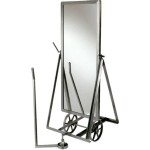How To Make A Room Look Bigger With Mirrors
Mirrors offer a classic interior design solution for creating the illusion of spaciousness. Their reflective properties can dramatically alter the perception of size and depth in a room, making even the smallest spaces feel more open and airy. Strategic placement and thoughtful selection of mirror types are key to maximizing this effect.
One of the most effective ways to utilize mirrors for expanding a room’s visual dimensions is to position them opposite windows. This placement allows the mirror to reflect the natural light streaming in, effectively doubling the light source and creating a sense of greater depth. The reflected outdoor view also contributes to the illusion of expanded space, blurring the lines between the indoors and outdoors.
Large mirrors can have a significant impact on a room's perceived size. A single, oversized mirror placed strategically on a wall can create a dramatic focal point while simultaneously adding a sense of depth. This is particularly effective in smaller rooms or narrow hallways where space is limited. Positioning a large mirror at the end of a hallway can visually extend its length, making it appear more spacious.
Floor-to-ceiling mirrors are another powerful tool for visually expanding a room. These mirrors maximize light reflection and create a sense of vertical expansion, making the ceiling appear higher. They also create a continuous reflective surface that visually pushes the walls back, contributing to a feeling of greater overall spaciousness. Consider placing a floor-to-ceiling mirror in a smaller bedroom or dining area to maximize its impact.
In addition to large mirrors, smaller, strategically placed mirrors can also contribute to the illusion of spaciousness. Grouping smaller mirrors together in a gallery wall formation can create a visually interesting focal point while also reflecting light and visually expanding the wall area. This approach allows for flexibility and creativity, letting individuals customize the arrangement to suit their personal style and the room's decor.
Mirrored furniture offers a subtle yet effective way to enhance the sense of space within a room. Mirrored surfaces on furniture pieces like chests of drawers, nightstands, or console tables reflect light and surroundings, creating a sense of depth and openness. This approach is particularly effective in rooms where wall space for hanging mirrors is limited. The reflective surfaces of mirrored furniture seamlessly blend into the room's decor while subtly contributing to the overall illusion of spaciousness.
Mirrored closet doors are a practical and stylish solution for maximizing space perception, especially in bedrooms where closets often take up significant wall space. Replacing traditional closet doors with mirrored ones effectively transforms the closet into a reflective surface, visually expanding the room and adding depth. This is particularly beneficial in smaller bedrooms where maximizing every inch of space is crucial.
The shape of a mirror can also influence its effect on a room's perceived size. Round or oval mirrors can soften the lines of a room and create a sense of flow, while rectangular or square mirrors can add a sense of structure and formality. Choosing a mirror shape that complements the existing decor and architectural features of the room can enhance the overall aesthetic while contributing to the illusion of spaciousness.
The frame of a mirror also plays a role in its impact on a room's perceived size. A thin or minimalist frame allows the mirror's reflective surface to take center stage, maximizing its space-enhancing properties. Conversely, a thick or ornate frame can draw attention to the mirror as a decorative element, potentially diminishing its impact on the perception of space. Consider the desired effect when selecting a frame, opting for a thinner frame when maximizing space is the primary goal.
Positioning mirrors near light sources, such as lamps or sconces, can amplify the light reflection and enhance the illusion of spaciousness. The reflected light creates a brighter and more open atmosphere, further contributing to the perception of a larger room. This technique is particularly effective in rooms with limited natural light.
Experimenting with different mirror placements and sizes is crucial to achieving the desired effect. Consider the room's layout, existing furniture, and natural light sources when determining the optimal placement for mirrors. Start with smaller mirrors and gradually experiment with larger sizes and different placements until the desired level of spaciousness is achieved.
Consider the overall style and decor of the room when selecting mirrors. The mirror's style should complement the existing decor, creating a cohesive and harmonious look. Whether it's a modern, minimalist frame or a more traditional, ornate design, the mirror should integrate seamlessly with the overall aesthetic of the room.
Maintaining clean mirrors is essential for maximizing their reflective properties. Regularly cleaning mirrors ensures optimal light reflection and prevents dust and smudges from diminishing their impact on the room's perceived size. A clean mirror effectively reflects light and surroundings, contributing to the illusion of spaciousness.

7 Ways To Make Your Home Look Bigger With Mirrors

20 Creative Ways To Use Mirrors That Will Make Your Space Look Bigger

How To Use Mirrors Make A Room Look Bigger

7 Ways Mirrors Can Make Any Room Look Bigger Sonoma

Do Mirrors To Make A Room Look Bigger

Modern Use Of Mirrors To Visually Enlarge Small Spaces Binswanger Glass

Here S How You Can Use Mirrors To Make Your Space Look Bigger

11 Ways To Use Mirrors Make Your Space Look Bigger

Mirror Tips And Tricks Using Mirrors To Make A Room Look Bigger

13 Ways To Make A Small Living Room Look Bigger Design Rooms Mirrors








